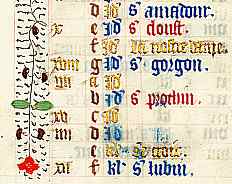


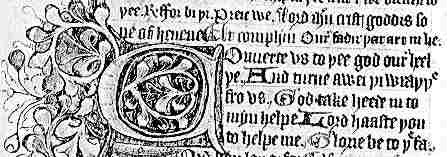
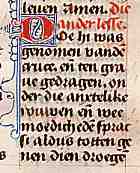


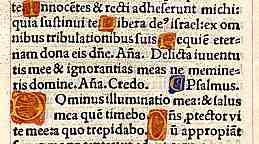
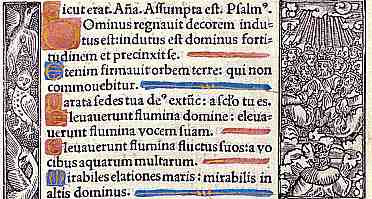
If you are looking at this page without frames, there is more information about medieval writing to be found by going to the home page (framed) or the site map (no frames).
| Personal Devotion and Books of Hours (4) | ||||||
| Vernacular volumes could be elegant productions with formal Gothic scripts and all the fancy decorative elements found in the high quality Latin works, as seen in the French language calendar shown here. |  |
|||||
| Segment of a calendar from a northern French book of hours of the later 15th century, from a private collection. | ||||||
| As well, the use of more rapidly written hybrid scripts appears to have combined with simpler production values to make these works more accessible to those with more modest budgets. | ||||||
 |
Sample from a French language book of hours from around 1500, from a private collection. | |||||
 |
Sample from a book of hours in Dutch or German dialect, from a private collection. | |||||
 |
||||||
| Segment from a Prymer, or English language book of hours, from the early 15th century (British Library, add. ms. 36683, f.23b). (From New Palaeographical Society 1906) | ||||||
| Books of hours in English were apparently much less common than ones in French. It is surmised that authoritarian condemnation of Lollardy in England in the 15th century may have worked against them. However, while English language Bibles were supposedly banned (although there were a lot of them about), books of hours were not, and they do exist. The use of the term prymer for these books indicates a common function for them; they were the first books used for teaching reading to children. | ||||||
| In the Netherlands, the book of hours in the Dutch language was immensely popular, particularly a version by Geert Grote, a member of a movement called the Brethren of the Common Life. This not only contained standard Latin texts from the use of Utrecht translated into Dutch, but included its own version of the hours. These survive in volumes plain and fancy. |  |
|||||
| Segment from a page from a Dutch book of hours of c.1420, from a private collection. | ||||||
| The choice of language was not absolute. Some Latin books of hours in France contained prayers, notably the Joys of the Virgin, in French. Latin books of hours had vernacular rubrics to help those whose Latin was a bit wobbly to find where they were up to, and vernacular works had Latin rubrics, because these terms were familiar. | ||||||
 |
A French rubric on a page of a 15th century Latin book of hours, by permission of the University of Tasmania Library. | |||||
 |
A Latin rubric in a detail from a page from a late 15th century Dutch book of hours, from a private collection. | |||||
| With the advent of printing, the book of hours became available to even more people. Printed volumes were being turned out in the early 16th century. The texts and general layout were the same, and the manual handiwork continued in the production of illuminated initials and line fillers. Rubrics were often no longer red, as this was a technical issue with the typesetting process. Block printing allowed for complex programs of illustration, but in monochrome. Some printed books of hours had handpainted miniatures inserted. While early printers experimented a bit with typefaces, those chosen for books of hours seem to have been mainly Italianate styles derived from humanistic minuscule. | ||||||
 |
This sample from a plain page has gilded initials, rubrics which are not red, and a humanistic typeface. The text is from the Office for the Dead. | |||||
| Sample from a leaf printed in Paris in 1517, from a private collection. | ||||||
 |
This sample shows a couple of the strangely eclectic decorative border elements, produced by block printing and seemingly assembled from a miscellany of sources. | |||||
| Segment of a page printed by Hardouin of Paris in the early 16th century, from a private collection. | ||||||
| The use of printing would seem to lead to standardisation of the text of the book of hours, but the co-existence of printing and manuscript in various forms meant that medieval readers still had complex relationships with their books. | ||||||
|
|
||||||
|
|
||||||
|
If you are looking at this page without frames, there is more information about medieval writing to be found by going to the home page (framed) or the site map (no frames). |
||||||